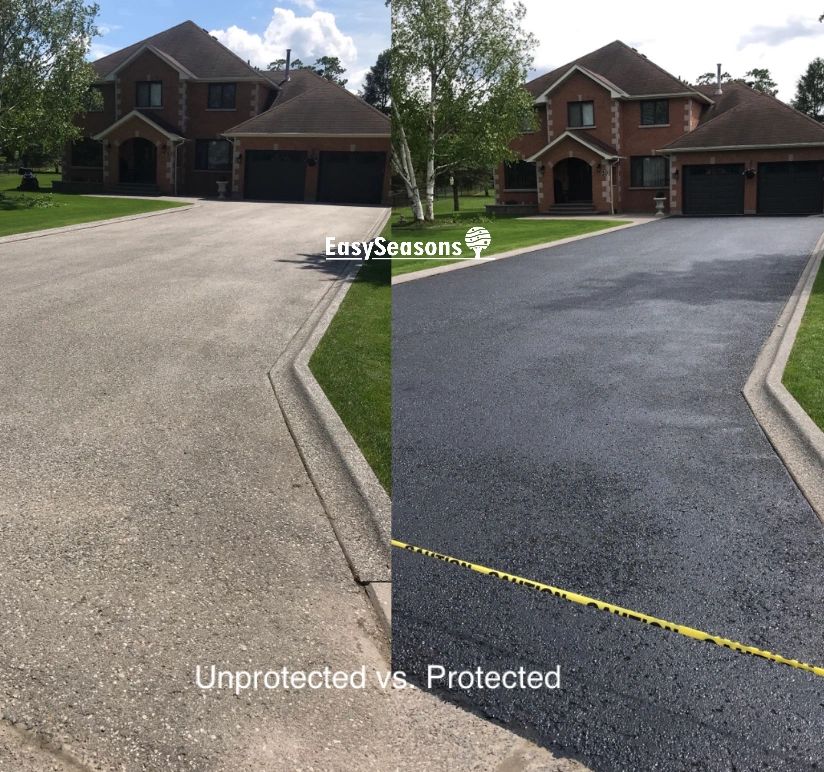Make The Most Of Financial Investment Returns: Angled Parking Lot Excellence with Asphalt Sealing
Wiki Article
Warm Mix Asphalt: A Lasting Service for Pavement
Hot Mix Asphalt (HMA) has become a leading sustainable option for pavement services, providing a myriad of environmental advantages and cutting-edge technologies. Its capacity to reuse products and minimize energy consumption presents an engaging situation for its fostering in roadway building and construction jobs. The long-term efficiency and longevity of HMA make it a favored choice for framework development. As the demand for eco-friendly construction techniques expands, discovering the nuances of HMA's sustainability can provide valuable understandings right into the future of sidewalk services.Environmental Advantages of Hot Mix Asphalt

Additionally, Warm Mix Asphalt helps to minimize urban heat island impacts. Its dark shade soaks up sunshine, minimizing the amount of warmth showed back right into the environment compared to lighter-colored sidewalks. This can lower ambient temperature levels in city locations, decreasing the need for a/c and inevitably decreasing energy usage.
On top of that, Hot Mix Asphalt contributes to enhanced stormwater monitoring. Its permeable nature permits water to infiltrate the pavement and charge groundwater supplies, decreasing overflow and the threat of flooding. These environmental benefits make Hot Mix Asphalt a lasting option for leading highways and roadways.
Power Performance in HMA Production
Is power performance an essential variable in the production of Hot Mix Asphalt (HMA)? Power plays a considerable function in the production of HMA, influencing both expense and environmental sustainability. One crucial aspect of power effectiveness in HMA production is the usage of cozy mix asphalt (WMA) technologies.Moreover, developments in plant technologies have actually led to more energy-efficient HMA manufacturing processes. By enhancing power use in HMA manufacturing, the market can lower its carbon footprint while preserving high-grade pavement materials.
Recyclability of Warm Mix Asphalt
The recyclability of Hot Mix Asphalt (HMA) is an essential facet of its sustainability and long-term environmental influence. HMA is one of the most recycled products in the USA, with over 100 million tons of redeemed asphalt pavement (RAP) being reused yearly in brand-new sidewalk building and construction. Recycling HMA supplies several environmental benefits, such as minimizing the requirement for virgin products, reducing power intake throughout manufacturing, and lowering the amount of waste sent to garbage dumps.The process of reusing HMA includes grating the existing pavement, squashing original site it right into smaller items, and blending it with new aggregate and asphalt binder to produce a recycled mix. Generally, the recyclability of HMA plays a considerable role in promoting lasting methods within the sidewalk sector.

Long-Term Efficiency of HMA
Asphalt pavements demonstrate toughness and strength over an extensive duration, reflecting the long-term performance of Hot Mix Asphalt (HMA) The longevity look at this website of HMA can be attributed to its ability to endure hefty web traffic tons, extreme weather, and the impacts of aging. Researches have actually revealed that properly designed and appropriately constructed HMA pavements can last for 20 years or more with normal upkeep. The secret to making best use of the lasting efficiency of HMA hinges on utilizing top notch materials, following finest techniques in building and construction, and applying reliable maintenance strategies. Correct water drainage, routine inspections, and prompt repair services are vital for preserving the architectural integrity of HMA pavements with time. Additionally, advancements in HMA modern technology, such as using polymer-modified binders and warm mix asphalt, have actually additionally enhanced the toughness and durability of HMA pavements. By focusing on quality building and construction and upkeep methods, HMA remains to confirm itself as a sustainable and cost-efficient option for long-lasting sidewalk infrastructure.
HMA: Sturdiness and Sustainability
Demonstrating both longevity and sustainability, Hot Mix Asphalt (HMA) has come to be a foundation in the construction of resilient pavement frameworks - angled parking. HMA's durability stems from its capacity to stand up to hefty tons, harsh climate condition, and high web traffic quantities, making it a trusted option for roads, highways, and flight terminal paths. The composition of HMA, which generally consists of aggregates, binder, and filler, plays a vital role in improving its durability and resistance to tear and wear
In addition, HMA's sustainability depends on its recyclability and energy-efficient production procedure. The capacity to recycle recovered asphalt sidewalk (RAP) in brand-new HMA mixes minimizes the need for virgin materials and decreases the environmental effect of sidewalk construction and maintenance. Furthermore, the power effectiveness of producing HMA lies in its lower mixing temperature levels contrasted to various other pavement materials, causing minimized power usage and greenhouse gas exhausts.
Verdict
To conclude, hot mix asphalt (HMA) provides a lasting service for pavement with its eco-friendly qualities. HMA's recyclability, energy efficiency in manufacturing, and lasting toughness make it a green option for road building. By saving natural resources, reducing waste, and lowering greenhouse gas exhausts, HMA plays an important role in advertising sustainability in infrastructure growth. Its ability to mitigate urban warmth island impacts even more highlights its significance in creating environmentally mindful and resistant pavement systems.
HMA is one of the most recycled products in the United States, with over 100 million heaps of recovered asphalt pavement (RAP) being reused each year in new pavement construction.The process of recycling HMA includes crushing the existing sidewalk, squashing it right into smaller sized pieces, and blending it with brand-new aggregate and asphalt binder to create a recycled mix.Asphalt sidewalks show this post toughness and strength over a prolonged period, showing the long-lasting performance of Hot Mix Asphalt (HMA) Additionally, advancements in HMA technology, such as the use of polymer-modified binders and cozy mix asphalt, have better enhanced the toughness and longevity of HMA sidewalks. The capacity to reuse reclaimed asphalt pavement (RAP) in new HMA mixes minimizes the need for virgin products and decreases the environmental effect of sidewalk construction and maintenance.
Report this wiki page